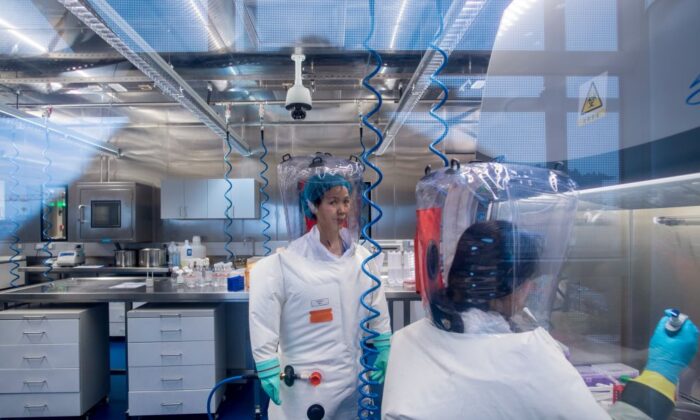“And the LORD said, Behold, the people is one, and they have all one language; and this they begin to do: and now nothing will be restrained from them, which they haveimagined Strongs 2161: zamam, zaw-mam´; a primitive root; to plan, usually in a bad sense:—consider, devise, imagine, plot, purpose, think (evil).to do. — Genesis 11:6
“And he had power to give life unto theimage Stronges 1504: eikon, i-kone´; from 1503; a likeness, i.e. (literally) statue, profile, or (figuratively) representation, resemblance: — image.of the beast, that the image of the beast should both speak, and cause that as many as would not worship the image of the beast should be killed" — Revelation 13:15
Throughout the world, scientific research and experiments involving ethical issues must first pass the scrutiny of ethics committees. In recent years, the Chinese Communist Party (CCP) has conducted many experiments in biomedical and genetic engineering that break human ethical boundaries.
China began implementing the Ethical Review of Biomedical Research Involving Humans on Dec. 1, 2016. However, 122 Chinese scientists who co-signed an open letter in 2018 to oppose gene-edited babies criticized China’s biomedical ethics review as a “sham.”
In the United States, as ethical and moral regulations on animal research have become stricter, budgets and funding have tended to decrease in recent years, making China the most attractive place for such experiments. For example, in 2014, the U.S. government imposed a funding pause of gain of function research involving influenza, severe acute respiratory syndrome (SARS) coronaviruses, and Middle East respiratory syndrome (MERS) coronaviruses. In 2019, the U.S. Environmental Protection Agency (EPA) announced that it would stop conducting or funding studies on mammals by 2035.
In 2011, the CCP made it a national development goal to create primate disease models through cloning and other biotechnologies. According to the 2020 China Biomedical Industry Development Report published by Chinese Venture, “the overall biopharmaceutical market in China increased from $28.7 billion to $49.6 billion from 2016 to 2019, at a CAGR (Compound annual growth rate) of 20 percent. It is expected to reach $130.2 billion in 2025.”
Below are four experiments conducted by Chinese scientists that Chinese state media touted as “world firsts.”
Experiment 1: A Rat Model of Male Pregnancy
On June 9, researchers from China’s Naval Medical University published a preprint paper on “a rat model of male pregnancy” on the non-peer-reviewed site BioRxiv.
The paper describes a specific method for getting a male rat pregnant at the expense of three female rats.
- First, a castrated male rat was sutured back to back with a female rat to create a female microenvironment for the male rat, forming a heterosexual parabiotic pair.
- The uterus of another female rat was transplanted into the conjoined male rat.
- Finally, blastocyst-stage embryos developed in the third female rat were transplanted into the grafted uterus of the male parabiont and the native uterus of the female parabiont.
- After 21.5 days, 27 of the 280 male embryos were normally developed, and 10 well-developed pups were delivered by cesarean section. At least 46 male rats and 138 female rats were used in the experiment.
Chinese web portal Sina reported the story under the headline “Are men still far away from giving birth?”, saying that “Chinese scientists have performed a miracle” and “broken the universal law of nature since the beginning of the time.”
However, the experiment has been questioned and criticized by some experts.
Emily McIvor, a senior science policy advisor for People for the Ethical Treatment of Animals (PETA), described the experiment as “vile.” She said that animals should not be treated as “disposable objects.”
“Animals deserve to be respected and left in peace, not bred in laboratories, experimented on, and treated as disposable objects,” she said to Mail Online.
“Surgically joining two sensitive rats—who endured mutilation and weeks of prolonged suffering—is unethical and in the realm of Frankenscience,” she added.
She also said she believes that “these shocking experiments are driven solely by curiosity and do nothing to further our understanding of the human reproductive system.”
Experiment 2: Human-Monkey Chimeric Embryos
On April 15, a research team from Kunming University of Science and Technology in Yunnan, China, and the Salk Institute for Biological Sciences in the United States published a paper on the Cell website, announcing that they had successfully grown the world’s first human-monkey chimeric embryos, i.e., embryos with both humans- and monkey-derived cells.
Scientists injected human stem cells into the monkey embryos hoping that the organs grown in the monkeys could be transplanted into humans. This has led to widespread ethical controversy.
Dr. Anna Smajdor, lecturer and researcher in biomedical ethics at the University of East Anglia’s Norwich Medical School, told the BBC the study posed “significant ethical and legal challenges.”
“The scientists behind this research state that these chimeric embryos offer new opportunities because ‘we are unable to conduct certain types of experiments in humans.’ But whether these embryos are human or not is open to question,” she said to BBC.
Prof Julian Savulescu, director of the Oxford Uehiro Centre for Practical Ethics and co-director of the Wellcome Centre for Ethics and Humanities, University of Oxford, told the BBC the research “opens Pandora’s box to human-nonhuman chimeras.”
However, the project’s Chinese leader, academician Ji Weizhi of the Chinese Academy of Sciences, said that human-monkey chimeric embryos just created an environment in which human stem cells are developed, reproductive chimerism does not inherently occur, and that it is “definitely not a human-monkey hybrid,” so it does not have ethical issues.
In 2019, the State Key Laboratory of Stem Cell and Reproductive Biology in Beijing created the first “pig-monkey hybrid” by adding monkey cells to pig embryos.
The two hybrids died after only two weeks, and the research was criticized by scientists from around the world as morally and ethically shocking.
Experiment 3: Gene-Edited Babies
In December 2018, Chinese scientist He Jiankui announced at a major academic conference in Hong Kong the birth of twin gene-edited baby girls who were “immune to AIDS.” He claimed it was the first case in the world.
He said his team used CRISPR technology to “edit out” the CCR5 gene in embryos so that the babies might have a natural ability to fight AIDS in the future.
The case sparked widespread condemnation from the global scientific community, with experts concerned that altering the genome of an embryo could cause unexpected harm, not only to the individual being modified but also to future generations who pass on these same changes.
Krishanu Saha, a bioengineer at the University of Wisconsin-Madison, a member of a group investigating the safety of the technology, told the BBC, “So let’s say we are injecting a genome editor into the brain to target neurons in the hippocampus, ” she adds, “how do we make sure that those genome editors do not travel into the reproductive organs and end up hitting a sperm or egg? Then that individual could potentially pass the edit on to their children.”
An international committee of scientific institutions investigating the issue released a report on Sept. 3, 2020, saying that once the genome of a human embryo is edited, it should not be used for reproduction until there is solid evidence that genomic changes in the sperm survivor can lead to reliable results and do not cause unintended changes. No genome editing technology has been able to meet this standard.
Even in China, 122 scientists signed an open letter warning of the risks of such experiments and criticizing the authorities’ “ethical biomedical review as a sham.”
The Chinese authorities opened an investigation shortly after the news was announced, saying that there were problems with the ethical review documents involved in the study.
CCP mouthpiece People’s Daily also changed its tone after praising the research as “a historic breakthrough” and published an article titled “Technological Development Cannot Leave Ethics Behind.”
On Dec. 30, 2019, a Chinese court ruled in a secret trial that He Jiankui will spend three years in prison and pay a $430,000 fine for “illegally carrying out the human embryo gene-editing experiments.” Two others involved were also sentenced.
Experiment 4: Gain-of-Function Experiments on Coronaviruses
“Bat Woman” Shi Zhengli, a scientist at the Wuhan Institute of Virology in China, sparked an ethical and moral debate by conducting a gain-of-function (GOF) experiment in the course of her research on the CCP virus, which causes COVID-19.
In 2015, Shi, together with her collaborators, published a paper in the journal Nature Medicine on the genetic modification of a SARS-like virus (SARS-CoV) bat coronavirus to infect humans with greater infectivity.
This GOF study, in which the virus was genetically modified to make it more lethal or transmissible, amounted to the creation of a new strain of the virus that was expected to cause an outbreak in humans, the so-called “potential pandemic pathogen (PPP).”
After the publication of the article, many scientists worldwide questioned the potential dangers and ethical issues of the experiment.
Because the risk of widespread or even global spread of virulent pathogens that could result from GOF/PPP research far outweighs the research benefits, such research has raised widespread ethical concerns. It has been deemed inconsistent with the Nuremberg Code‘s requirement for broad ethical principles of “fruitful results for the good of society, unprocurable by other methods,” and proportionality of risk to humanitarian benefit.
In 2014, the U.S. government suspended funding for GOF research involving influenza, Severe Acute Respiratory Syndrome (SARS) coronavirus, and Middle East Respiratory Syndrome (MERS) coronavirus.
In August 2020, Michael J. Imperiale, professor in the Department of Microbiology and Immunology at the University of Michigan, and Arturo Casadevall, professor and chair of the Department of Molecular Microbiology and Immunology at Johns Hopkins Bloomberg School of Public Health, co-authored an article saying that “we are not concerned with the notion of gain-of-function experiments writ large … Rather, we are specifically talking about experiments involving pandemic pathogens.”
They added, “One should not be performing GOF experiments simply to ‘see what would happen’ without strong evidence that it could happen naturally. In other words, just because an experiment can be done does not mean that it should be done.”
In an email to the New York Times on June 15, Shi argued that her experiment was different from GOF because her goal was not to make the virus more dangerous but to understand how it spreads across species.
Dr. Sean Lin, former lab director of the viral disease branch of the Walter Reed Army Institute of Research, told The Epoch Times Chinese-language edition that the cross-species experiment itself would create new viruses that are not found in nature, making them not only more virulent or infectious, but also helping the virus mutate and leading to cross-species mutations.




